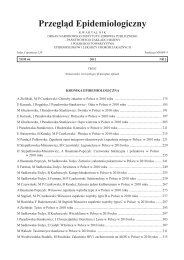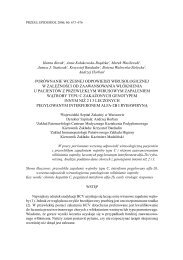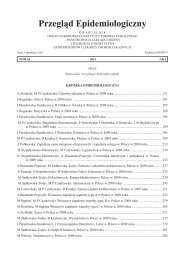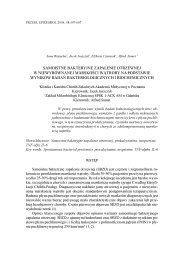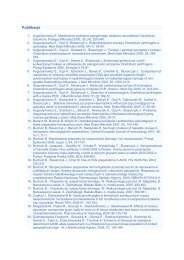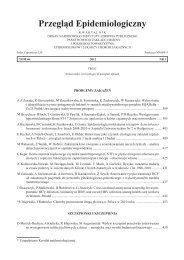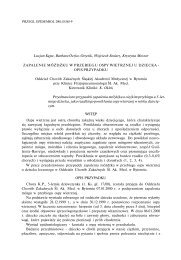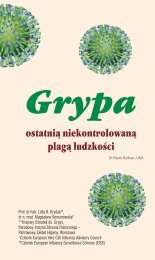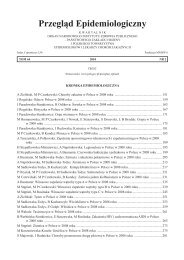Przegląd Epidemiologiczny - Państwowy Zakład Higieny
Przegląd Epidemiologiczny - Państwowy Zakład Higieny
Przegląd Epidemiologiczny - Państwowy Zakład Higieny
You also want an ePaper? Increase the reach of your titles
YUMPU automatically turns print PDFs into web optimized ePapers that Google loves.
Nr 1 Fig. 4. The rate of Status protection of immunity against children vaccine-preventable after hematopoietic disease stem cells in transplantation autologous and97allogeneic group at the time of revaccination was commenced (p=NS).Fig. 4. Ryc.4. The rate Odsetek of protection osób po against przeszczepie vaccine-preventable autologicznym disease i allogenicznym in autologous and z ochronnym allogeneic group poziomem at the time of revaccinationprzeciwciał was commenced w czasie (p=NS) rozpoczęcia szczepień (p=NS).Ryc.4. Odsetek osób po przeszczepieniu autologicznym i allogenicznym z ochronnym poziomem przeciwciał w czasierozpoczęcia szczepień (p=NS)– protective level – below protective levelD – diphtheria, D – diphtheria, HBV – hepatitis HBV – hepatitis B virus, Hib B virus, – Haemophilus Hib – Haemophilus influenzae type influenzae B, T – tetanus, type B, T – tetanus,V – varicella V – varicellaImmunization, which is not for various reasonsintroduced consistently at all transplant centers (12),are important for two main reasons. First, the most important,is the need to protect the patients treated withHSCT against serious vaccine-preventable infectionsthat may occur after transplant (7). Second, is the publichealth consideration point of view, to lower number ofindividuals vulnerable to important infections agents(6). Moreover, no data are currently available to suggestthat routine immunization after HSCT should notbe recommend.During the last three decades, several studies havebeen published regarding the loss of pretransplantimmunity. The most important factors are: type oftransplant (autologous or allogeneic), regimen givenbefore transplant, appearance and intensity of GvHD,immunosuppressive therapy given afterwards, type ofdonors and their serological status. The loss of immunityseems to depend on the strength of existing pretransplantimmunity in the patients and, to some extent, the immunitystatus of the donor (6).Especially in children after HSCT it should beexpected more rapid loss of immunity or total lackthereof, due to the primary serious disease.In our study the scheduled vaccination protocol wasperformed only partially, or patients were not vaccinatedat all even though children were diagnosed with a meanof 7 years (fig.1). Despite same differences in recoveryof immunity after autologous and allogeneic HSCT, therisk of losing immunity to several infections agents (e.g.hepatitis B virus, tetanus, diphtheria, varicella and Haemophilusinfluenza type b) are similar in both groups.Although exists the hypothesis that immunity canbe transferred adoptively from the donor to the recipientthrough an allograft, the durability of this immune responseis uncertain, and most data suggested a fall inthe antibody titers during the 1 – 10 years after HSCT,if the recipient is not revaccinated. Moreover, adoptivetransfer of antibody responses is possible only for recallantigens. Transfer of responses to priming antigens,which would broaden the range of organisms againstwhich patients can be protected is not successful (13).Some of authors suggested that the transfer of immunitymay be a consequence of mature T and B cellscontamination of the harvested donor marrow or bloodstem cell (13). Virtually all HSCT recipients rapidly lossall T- and B-lymphocytes after conditioning regimen(high dose chemotherapy with or without radiation orimmunosuppressive therapy), losing immune memoryaccumulated through a lifetime of exposure to infectionsagents, environmental antigens, and vaccines. Most ofthe circulating T cells in the first year after transplantation,particularly in adults, are memory/effector Tcells, likely derived from cells infused with the graftand capable of responding to antigens encounteredby the donor before transplant. Naïve T cell capableof responding to new antigens are generated > 6 - 12months after HSCT. Similarly, regardless of the time torecovery, newly generated B cells often show impairedantigen specific responses because of limited capabilityof naïve B cells to undergo somatic mutation and isotypeswitching during the first year after HSCT (7).In presented group at the median time of 29 (range6 – 67) months after autologous and 13 (range 8 – 33)months after allogeneic HSCT, when the revaccinationwas commenced, the majority of children had concentrationof antibody lower than the minimum protectivethresholds for tetanus (82%), Hib (71%), varicella(71%), HBV (46)% and diphtheria (38%).This results strongly suggest a routine revaccinationin all HSCT pediatric recipients after transplantationso that they can experience immunity to the vaccine--preventable diseases as others in general population.



